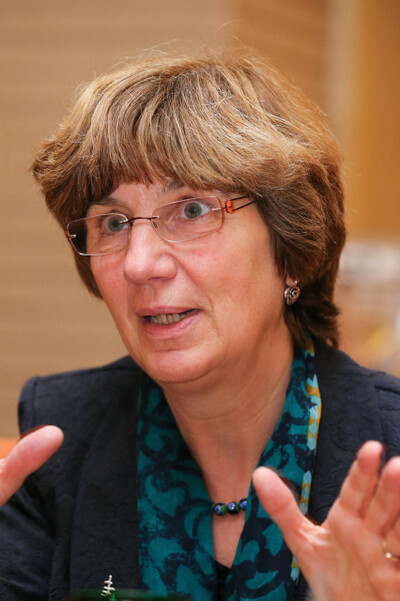hankyoreh
Links to other country sites 다른 나라 사이트 링크
Dutch unionist throws water on Pres. Park’s plans to “look Dutch”

By Im In-tack, staff reporter
Can the Park Geun-hye administration pull off its “look Dutch” strategy of increasing employment through part-time work?
In the Netherlands, 37% of all workers worked less than 35 hours a week in 2011. The country has one of the highest rates of part-time employment in the OECD, where the average is 16.5%. And with its high rates of productivity and worker satisfaction, some have taken to calling it the world’s “first part-time economy.”
But Catelene Passchier, vice president of FNV, the country’s largest labor union, said the Park administration’s “road map” for part-time jobs is “too ambitious.”
“An employment rate of 70% through more part-time work is asking too much,” Passchier said. “Korea’s in a similar situation now to the one we were in during the 1980s and 1970s, where making sure there are good jobs is more important than raising the employment rate. But the part-time jobs in Korea don’t seem to be very good - the wages, promotion chances, and job security are too low.”
Passchier, a lawyer, said a higher employment rate was not the main goal of the Dutch part-time employment system.
“Mostly, it was a compromise between labor, management, and the government from the 1980s to increase workforce participation by women, divide up men’s and women’s duties in the home, and reduce male-centered, long-hours labor,” she explained.
In 1982, the Wassenaar Arrangement between labor, management, and the Dutch government laid the groundwork for reduced working hours, increased availability of child care and other facilities for women working part time, and started a trend of part-time work in the public sector. A 1993 agreement for women’s labor and part-time work banned discrimination in hourly pay, allowances, pensions, and social security between hourly and full-time workers. By collective agreement and law, workers were guaranteed the freedom to move between part-time and full-time systems, and to demand longer working hours from their employers.
“If it’s the same or similar work, the hourly wage rates are the same,” said Passchier of the Netherlands.
“Public servants tend to work three or four days a week full-time, while some younger men are opting to take what they call ‘Papa days’ to raise children and do housework,” she added.
The situation is very different in South Korea, where many of the public servants working part-time when the system is introduced next year are actually likely to end up doing unpaid overtime - compelled to stay by an unwritten law demanding that no one leave before the boss does. At the same time, the wage gap with full-time workers continues to grow the longer a person works part time.
According to the administration’s plan, part-time government employees would be enrolled in the national pension rather than the government employees’ pension, and those hoping to switch to full time would have to take the government employee examination all over again.
“South Korea is structured so that people can’t shift to full time or work more even if they want to,” Passchier said. “It’s important to have some kind of system for adjustments in place.”
Please direct questions or comments to [english@hani.co.kr]

Editorial・opinion
![[Column] Has Korea, too, crossed the Rubicon on China? [Column] Has Korea, too, crossed the Rubicon on China?](https://flexible.img.hani.co.kr/flexible/normal/500/300/imgdb/original/2024/0419/9317135153409185.jpg) [Column] Has Korea, too, crossed the Rubicon on China?
[Column] Has Korea, too, crossed the Rubicon on China?![[Correspondent’s column] In Japan’s alliance with US, echoes of its past alliances with UK [Correspondent’s column] In Japan’s alliance with US, echoes of its past alliances with UK](https://flexible.img.hani.co.kr/flexible/normal/500/300/imgdb/original/2024/0419/2317135166563519.jpg) [Correspondent’s column] In Japan’s alliance with US, echoes of its past alliances with UK
[Correspondent’s column] In Japan’s alliance with US, echoes of its past alliances with UK- [Editorial] Does Yoon think the Korean public is wrong?
- [Editorial] As it bolsters its alliance with US, Japan must be accountable for past
- [Guest essay] Amending the Constitution is Yoon’s key to leaving office in public’s good graces
- [Editorial] 10 years on, lessons of Sewol tragedy must never be forgotten
- [Column] A death blow to Korea’s prosecutor politics
- [Correspondent’s column] The US and the end of Japanese pacifism
- [Guest essay] How Korea turned its trainee doctors into monsters
- [Guest essay] As someone who helped forge Seoul-Moscow ties, their status today troubles me
Most viewed articles
- 1[Column] The clock is ticking for Korea’s first lady
- 2After 2 months of delayed, denied medical care, Koreans worry worst may be yet to come
- 3[Column] Has Korea, too, crossed the Rubicon on China?
- 4[Editorial] When the choice is kids or career, Korea will never overcome birth rate woes
- 5[Correspondent’s column] In Japan’s alliance with US, echoes of its past alliances with UK
- 6Hong Se-hwa, voice for tolerance whose memoir of exile touched a chord, dies at 76
- 7US exploring options for monitoring N. Korean sanctions beyond UN, says envoy
- 8Samsung barricades office as unionized workers strike for better conditions
- 9US overtakes China as Korea’s top export market, prompting trade sanction jitters
- 10[Photo] Smile ambassador, you’re on camera